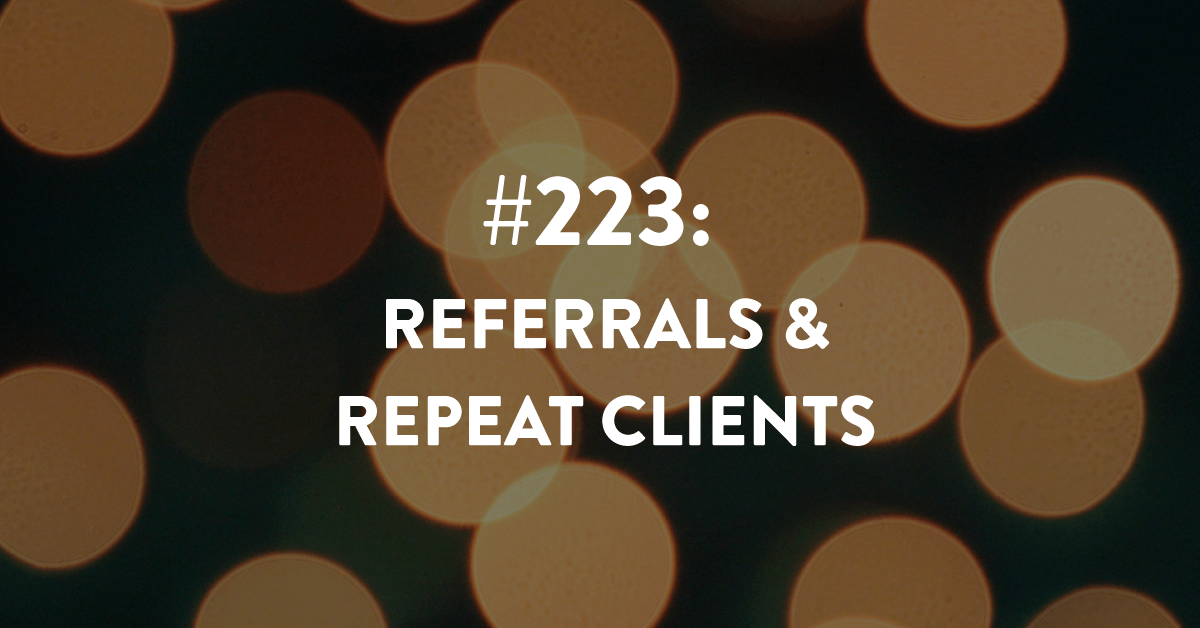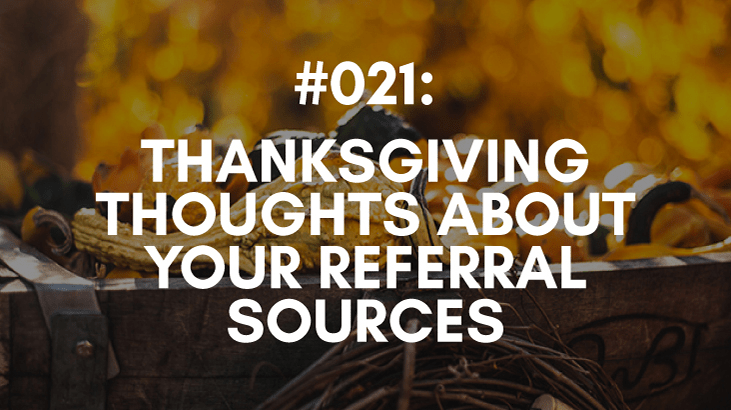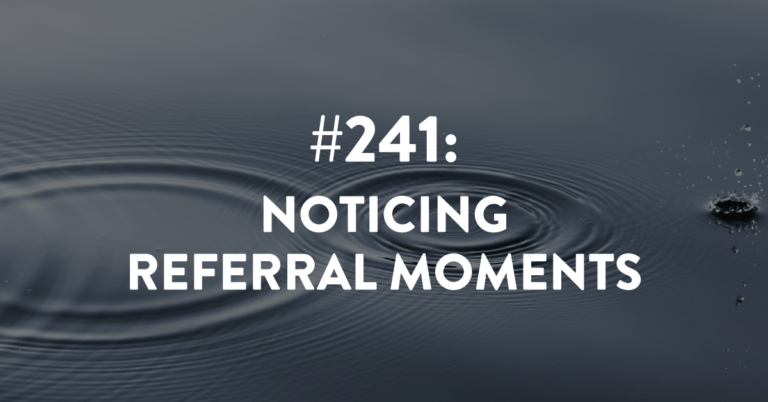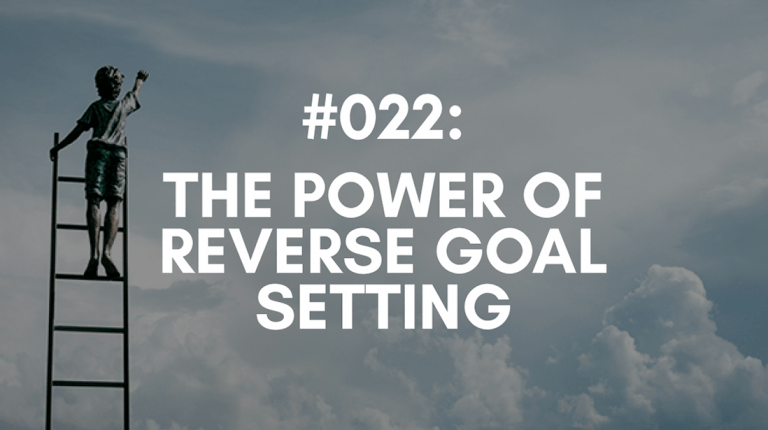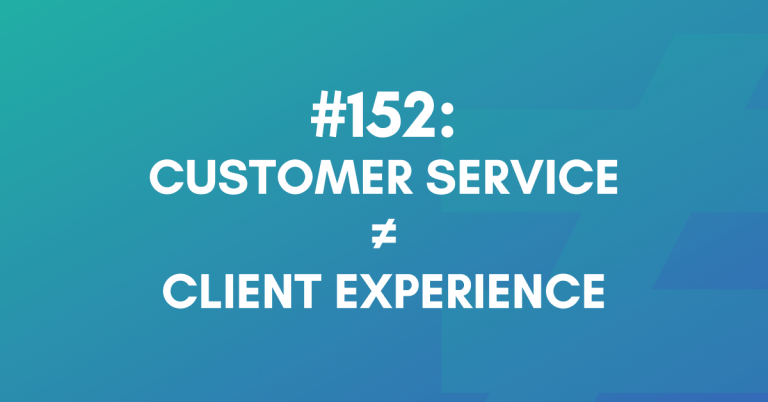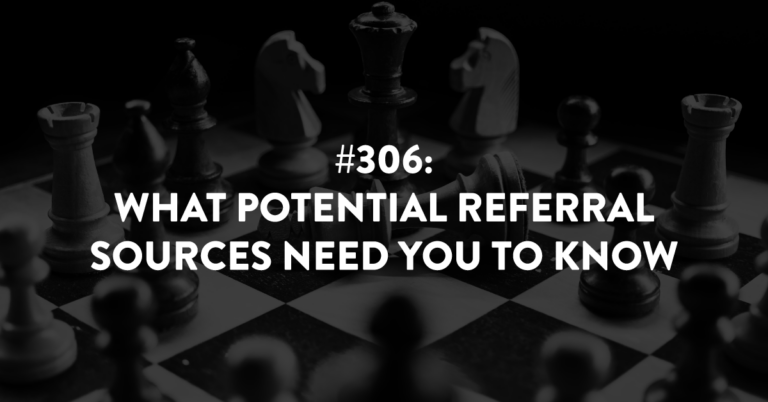Ep #223: Referrals and Repeat Clients
When we start putting a game plan into action within our business, there can be some confusion around referrals and repeat clients. This confusion comes from an overlap in the sales training space when it comes to turning prospects into clients, getting clients to work with you again, and getting clients to refer you.
Other advisors and coaches may tell you that all you need to do is stay in contact with your prospects and clients in order to eventually receive referrals. However, when it comes to getting referrals from clients or prospects, we need to go above simply keeping in touch with them.
In this episode, I will explain exactly what it is that you need to do to generate those referrals and the steps you can take to ensure you don’t miss an opportunity in the future!
Links Mentioned During the Episode
Chris Pentrack and Chris Cynkar share their experience building a referable business. Check out their episode here.
Larry Kendall’s book, Ninja Selling
Michael Maher’s book, 7 Levels of Communication
Looking for Referral & Client Experience Resources:
Take the Referral Ninja Quiz to test your skills and abilities at generating referrals. (FREE)
Buy my book – Generating Business Referrals Without Asking – and learn how to generate referrals through my 5 steps. (LESS THAN $16)
Check out our free resources on our Freebie Page. We have broken the free resources into two sections, based on if you’re less than 2 years in business or more than 2 years in business. Enjoy!
Consider joining Building a Referable Business™ – a unique way to learn all of my referral strategies and tactics with ongoing weekly access to me to answer your questions and help hold you accountable! Check it out and submit your application today!
Coming Up:
Next episode is #224, and we’re talking about the goals of referrals.
Download The Full Episode Transcript
Read the Transcript Below:
Stacey Brown Randall: Sometimes the nuances of referrals trips people up, and it has them deploy the wrong strategy. I see this a lot when it comes to referrals and repeat clients. So, I’m going to clarify it for you.
Hey there, and welcome to episode 223, of the Roadmap To Grow Your Business Podcast; a show about helping you build a referral business. I’m your host, Stacey Brown Randall.
Quick shout out to clients Chris Pentrack, and Chris Cynkar, the two of my clients who shared their results and experience of working with me on the podcast recently, in episode 221.
If you haven’t heard them explain why they turned their focus to referrals, what was about the why now for them, what their results were because while their results were very different, they were amazing and stellar.
You’ve just got to hear them talk about the reason they wanted referrals and how they wanted to receive referrals, what type of referrals they were looking for. And then of course, the ROI from being able to get those results from working with me in my programs.
So, I will link to that episode, if you haven’t heard them talk about all the things about their success and their why, and that’s episode 221. So, of course I’ll link to it in the show notes for this episode. The show notes for this episode is staceybrownrandall.com/223, that’s for episode 223.
But again, if you haven’t heard the Chris and Chris show, if you haven’t heard the episode with Chris and Chris, definitely, definitely take a minute and go listen to it. It will be inspiring for you.
Coming up every December, I turn my attention to teaching my Reverse Goal Setting Process. This year, I’m teaching it live in Charlotte on December 5th. This is something I haven’t done in years, like years prior, even to the pandemic. I think the last time I taught my Reverse Goal Setting Process live to like people in the room with me was probably 2018, I think.
So, I invite you to join me in Charlotte for this epic day. We will be getting ready for more than just 2023, hence, the reversing part of my Reverse Goal Setting Process, so you can have the best year next year.
We’ll be hanging out in the historic South End District, just outside of Uptown, and I’d love for you to join me in my beloved Queen City. And of course, signing up soon means that you get to take advantage of our early bird pricing.
So, all the details, plus the link to take advantage of that early bird pricing will be released next week right here on the podcast. So, make sure you are listening to next week’s episode, so you can get that link and go ahead and sign up to join me for the Reverse Goal Setting Process on December 5th, live in Charlotte. It’s going to be great.
I was just looking at catering menus the other day, oh my gosh, it’s going to be … just the food alone, it’s going to be fabulous.
And also, for my GBR students, that’s right, my Growth by Referral students, you can add on an additional half day, the afternoon of December 4th, where with my BRB members, who of course, are there complimentary because they’re BRB members, we will be focused on all things referrals, and building your referral plan for 2023.
So, we’ll have all the information coming out next week, be on the lookout for it. I can’t wait to have you join me.
Let’s dive into our episode. There can be some confusion with referrals when we start digging in and putting a game plan into action within our business. Some confusion rests on decades, I mean, decades of old, bad, tired advice. Other confusion though, has to do more with the nuances of referrals.
The confusion I see a lot and that I want to tackle in this episode is specific to referrals and repeat clients. Where I see the confusion come in as to how people are dealing and how they’re thinking about dealing with repeat clients and referrals, is this overlap that I see in this sales training space, when it comes to these three tactics.
Now, there’s lots of things taught in sales training, in that sales training space, and business development sales. There’s lots of things that are taught, but there is some overlap with these three specific tactics that I think also leads people to try to deploy one strategy for all three instances. And it’s just not really what we should be doing.
So, these three tactics or these three processes that you should have in place in your business are one, turning prospects into clients. So, someone who’s interested in your business, getting them to say yes, and paying you to be a client.
Number two, getting clients to work with you again. That means getting them to come back around and do something else with you, or the same thing again with you. And three, getting clients to refer you.
Okay, quick disclaimer; I know you guys know that referrals don’t only come from clients, but in this episode, it’s the one category of referral sources I’m focusing on. So, you’re going to hear me talk about referrals from clients. Just know, I know you know, obviously, there are three other types of referral sources. But for this episode, we are just focusing on referrals from clients.
So, this overlap of these three areas where you need processes in place — you need a process in place to nurture your prospects into clients. You need a process in place to be able to make sure that you’re staying in contact with your clients so that when the opportunity comes back around for them to hire you again; they hire you and not somebody else. And then of course, we all want our clients to refer us.
Those are three distinct processes or procedures or strategies or plans, whatever you want to call it; that you really need to have in place in your business.
Now, some people teach that you should stay in touch with your prospects and your clients. To get the prospects to become clients, nurture them, stay in touch with them until they say yes to becoming a client, and of course, to get your clients to work with you again. But they also say that you should stay in touch with your clients to get them to refer you.
Here’s the thing; for the first two, staying in touch or in contact with prospects so you can nurture them into clients, and of course, staying in touch and in contact with clients so they can become repeat clients, I wholeheartedly agree with. I do believe those are processes that you should have in place.
It may just be as simple as like a follow-up email drip campaign, or it may be more involved than that. But you should have something where you were staying in contact, staying in touch with your prospects, to nurture them along to becoming a client, and that you should also be doing the same with your clients when they’re done working with you to nurture them into becoming a repeat client, if that’s how your business works.
But when it comes to getting referrals from them, we need to elevate above the keeping in touch, keeping in contact tactics. It’s just not going to work the way you think.
So, here’s what I mean. Let me break these three down for you, and then we’ll talk a little bit about the difference and the nuances of where I see people kind of get this stuff confused in their heads.
Prospects; you need to stay in front of them while they’re in the buyer’s journey. And if they come out of the buyer’s journey and their answer is not now, “Not yet, not now,” but it’s not a “No forever, don’t ever call me again, crazy person” — of course, no one says that to you.
But you do need to stay in front of prospects while they’re in the buyer’s journey, making the decision, and you do need to have a process in place to nurture them, if they are a not now.
There are some people who follow me for a year before they decide to take the plunge and work with me. There are others who read my book and like within 30 days, they’re working with me as a paying client. Just everybody comes at what they need at a different time.
So, I obviously, have strategies or processes in place to nurture those that may take a year to say yes, to working with me. And of course, processes in place to help that person who is like, “I’m going to give you my money right now.”
Obviously, you need to have processes in place to be available to help somebody right when they need it, because this is all about a prospect; recognizing that they need what you offer. Like they need a solution for a problem they have, and you offer the solution to solve their problem.
Lots of people need to solve the problem of referrals in their business, but that doesn’t mean they’re all ready at the exact moment they learn about me to really commit and put their money where their mouth is, and invest in a program or invest in working with me through BRB, my group coaching experience, where they’re actually ready to tackle it.
Some people have to get certain things ready or set in their business before they do it. Some people just the pain needs to be a little greater before they’ll pull the trigger and do something about it. We all come to decisions as business owners as to when to invest in different strategies, or when to invest in different things in our business when we need them.
And so, of course, it’s important that you have a process in place where you’re staying in front of those warmer, hot leads while they’re in the buyer’s journey, and then of course, you’re nurturing those who’ve come out of the buyer’s journey, and they’ve made the decision that no, not now, but maybe later.
And so, you need processes for that. And staying in front of them and keeping in touch, staying in contact is actually a great way to do that just so they know you are there when the time is right.
For clients, you want to make sure that when the client has moved to the alumni stage. So, when they were a new client and then they went to the new stage,, and then they went to the active state, and then they hit the point where the active stage ended, the work with you was done, and now, they’ve moved into an alumni stage.
Now, I call it alumni clients, because I think it’s a 10 times better term than just calling them previous clients, or old clients, or past clients. I mean, think about what do you want from an alumni of a university?
They want you to stay engaged, give money. They want you to stay connected to the university when you’ve graduated and become an alumni. And so, I apply the same term to clients, they’re alumni clients.
So, when a client’s done working with you, you need to make sure that they don’t forget about you, if there is always the potential for them to work with you again.
Obviously, this means that they had a great experience the first time around and they would want to work with you again, and your business is structured, and has a model to do repeat work with clients.
For a really long time, once somebody had invested in some of my online programs, there wasn’t anything else for them. And my clients kept saying, “Yeah, but I want to go to the next level with you. I want to work deeper with you. I want more access to you.”
And so, over the years, I would say over the last five or six years, there have been different ways that I have offered the opportunity for clients to be my repeat clients, to come back and work with me.
Whether that was upgrading to a VIP level that I used to offer that I don’t offer anymore, they get to work with me one on one. We started this a couple years ago, the inner circle, which is once you had been in my Growth by Referrals Program for a year, you could graduate into the inner circle, and that just gave you some additional training and stuff.
And all of that actually led me to the place where now, I have Building a Referral Business and lots of people who’ve joined BRB have actually renewed when their time was up. They’re like, “No, I’m staying in.” We offer like a maintenance plan once you’ve done one year in BRB, and they stay.
And so, I’ve got clients that have been with me through some iteration of whatever I was offering at the time for five, six years or longer. And so, it’s important that you think about your business structure from a client perspective, if what you do allows them to come back and work with you again.
Now, let’s look at this from the perspective of like a real estate agent. Not everybody’s buying a house every year. Maybe they’re investing and that’s great, but most people aren’t buying a new house every year.
But every couple of years, and I think the statistic is actually every seven years, maybe they are. And then let’s think about this from an interior designer’s perspective. And once you renovate my kitchen, I may not do a massive major renovation for a while, or maybe I will decide to do the master bedroom a couple years later.
So, there’s this idea that if your clients can come back to work with you, you want to make sure that they’re not forgetting about you to come back and work with you again. But now let’s talk about this from the referral perspective.
So, prospects and clients, prospects and repeat clients, those are strategies, those are tactics. How do you stay engaged with them? How do you stay in contact with them so that the prospect will eventually get to yes, from their not now?
And then how do you stay engaged with those clients so that they’ll come back around and be a repeat client for you when the time is right for them? Strategies and tactics, keeping in touch, good stuff.
But for referrals, if you want referrals from your clients, you’re really going to need a different strategy, one where you use the right language, which of course, we call referral seats, so that you can actually get them to refer you.
So, why is the follow-up, so to speak, different? Well, those clients who refer you are putting their reputation on the line. You need to be top of mind, which is elevated above just keeping in touch. You need to be top of mind when they come across potential opportunities so that they seize those opportunities to refer you.
It’s just a different type of relationship, and it’s a different type of outreach, and we definitely use a different type of language, which is when you hear people in the sales and marketing space, and they’re talking about just follow-up, just send your newsletter of content and you’ll get referrals, or just follow up with your people, your clients, and you’ll get referrals — it’s not that simple.
Yes, you can follow up with prospects and they can become clients. And yes, you can follow up with clients to have them become a repeat client. But if you want them to actually refer you, you’re going to need to build a different type of strategy.
Now, can you pick up some very low hanging fruit just by sending a newsletter or just by doing some content marketing of people who will see that and think to refer you? Yes. But it’s sporadic.
Anybody that’s ever done the asking strategy will tell you the exact same thing. They’re like, “Yeah, you ask a hundred people and only one person says maybe,” and then well, do they get back to you or not?
So, I’m not saying you can’t just follow up with clients and that will generate some referrals because it could, but they’re going to be sporadic and inconsistent. And what I’d like to teach is consistency and sustainability of growth, based on a strategy built to actually generate referrals. And that means it looks very different from just keeping in touch or just following up.
So, when you want referrals from your clients, you have to think about this differently than the follow up, keep in touch, put out some content, send out any newsletter. Or make sure you’re doing phone calls to those folks or text messages to those folks every 60 days. You got to do more. You got to elevate it.
Now, I don’t mean you got to do more in terms of, “Oh, you need to be contacting them every single day.” No, that’s called a stalker. Don’t do that. That’s bad.
What I mean, when I say elevate it, you got to do more, is I mean that you’ve got to be more top of mind with a memorable and meaningful way, and using language that kind of allows them to start thinking about you from a referral perspective, but you’re never directly asking for referrals. You’re not even hinting at future referrals. Like this is really key.
So, while an email or a postcard or some kind of drip campaign mixed in with maybe like the occasional holiday card or client appreciation event, that can actually work to keep in touch with clients to become repeat clients and prospects to become clients. You’re going to need something more to generate referrals from clients.
I want you to kind of think about this in a layering way, so to speak. You need to have a follow-up process for your prospects. What does that look like? If it’s a drip campaign of emails, what does that look like? If it’s emails mixed in with phone calls, mixed in with text messages, mixed in with something you mail, what’s the cadence? You need to have that process.
You need to have a stay-in-touch process for clients once they’ve moved into that alumni stage. Now, this is something I teach in my Referable Client Experience Program. That program’s not available for the general public to purchase. It’s actually only available right now inside my BRB program.
But one of the things we teach inside the Referral Client Experience Program is that you do need to have this client experience that makes you referable. So, the new stage, active stage, alumni stage.
And part of what we teach is when they’re in the alumni stage, to get them to be repeat clients and to refer you, is this process of how we’re staying in touch with them. But when we talk about referrals from our clients, then we’re starting to talk about a different type of strategy.
So, you need a different strategy for turning clients into referral sources. Sometimes it’s how you’re planting referral seeds throughout your client experience, which is what we teach in the referral client experience program.
Or sometimes, it’s what I call hand-to-hand combat, which sounds terrible. But hand-to-hand combat in terms of identifying clients that you want to refer you, and then deploying a very specific strategy to nurture them into referral sources, which I teach in our program, Referring Machines.
Some resources to consider — so, if you’re thinking about, “Okay, now, Stacey just told me I need a process to follow up with my prospects, a process to stay in touch with my clients when they’re done working with me so they’ll be repeat clients, and I’m probably going to have to consider some different strategies if I want to turn those clients into referral sources and get them to refer me.”
You’re thinking to yourself, “Oh my gosh, that’s three. That’s three new processes I need to put in place” That make better because most of you probably got a place where you have this in some format. Even if you don’t know it, you have some unintentional or intentional strategies in place, processes in place for these three things.
So, if you’re thinking about the follow up process for prospects or to the stay-in-touch process for clients, once you’re done working with them so there’ll be a repeat client, some resources to consider about staying in contact would be Larry Kendall’s methodology in Ninja Selling: where he teaches you staying in the flow with prospects and clients or your network. Or you could also check out Michael Maher’s, Seven Layers of Communication.
Now, these books and these experts, Larry and Michael, great, great, great guys. But they are focused in the real estate space. So, if you pick up their books and you’re like, “Wow, this is really for mortgage brokers or loan officers and real estate agents” — the reason why I’m recommending this is because I really actually believe that real estate agents or like the real estate industry in general, is one industry where staying in contact is a focal point of actually what is taught to those in the industry.
So, those are two books to check out. If you’re not in real estate, you may be like, “Eh, it’s really targeted at the real estate.” You may have to modify it to fit yours, but there’s some basic content in there about Larry Kendall’s methodology, staying in flow, Michael Maher’s Seven Levels of Communication of how you build relationships that are really important.
And that’ll help you with that following up process for prospects and the staying-in-touch process for clients to become repeat clients, and I’ll link to both of their books in the show notes, definitely worth maybe you guys tackling a good read for this fall.
But you are going to need something different. You’re going to need to elevate above that if you want to turn your clients into consistent referral sources. Not just get the one referral when they’ve had this amazing experience with you and they are thinking about you, and they tell someone about you, and you get that one referral — awesome, but I want consistent referrals from them.
And that takes a different nurturing strategy. And that takes a different way to generate referrals from your clients. And you’re going to need different strategies for that, that just staying in contact isn’t going to provide to you.
Now, before I let you go, I also just want to give you a quick side note about tracking referrals and repeat clients, because this is the other nuance where I see people get this confused.
Here’s a standard rule I want you to always realize; a client cannot refer themselves. Just remember that — a client cannot refer themselves. A client that comes back to work with you is a repeat client.
And so, when you’re categorizing that in however you track this, a CRM, an Excel spreadsheet, a piece of paper, whatever; however you track where your prospects and your new clients are coming from, if a client comes back around three years later to have you do some renovation in their home, because you’re an interior designer, or they come back around because now, you set up their articles of incorporation as an attorney for them a couple years ago, and now they need you to negotiate a contract — when a client comes back around, the way that you actually will tag that in your system, in your tracking, is they are a repeat client.
Even if that client were originally referred to you, when the first time they come to work with you, if they’re referred to you, that’s counted as a referral for the referral source, whoever was the person who referred that client to you.
But once the client comes back to you a second or a third time or longer and awesome, then of course, the source is a repeat client because a client cannot refer themselves.
I see that a lot when I work with folks in my programs, when I’m looking at their data, and I see they’ll have the client’s name and then the same name, the client’s name for the referral source as well, because they came back as a repeat. And I always have to say, “Nope, clean that up. That’s actually just a repeat client.”
So, that’s the other area where I see folks get kind of get stuck when it comes to the nuances behind referrals and repeat clients.
You got some homework to do. We covered a lot. A quick wrap up; I want you to think about your strategy for repeat clients, turning prospects into clients, and referrals. They’re three different strategies.
Have a follow-up process for your prospects to get them to say yes when they’re ready, have a stay-in-touch process for clients once they move to the alumni stage to get them to come back to be a repeat client.
And of course, you’re going to need something different. You’re going to need something more. And I don’t mean more often, I just mean better, a different strategy of turning clients into referral sources.
So, I mentioned some links in this episode, some resources in this episode as well, I’m going to link to those on the show notes page for this episode, which is staceybrownrandall.com/223.
Quick reminder, go ahead and put December 5th on your calendar right now. Make your travel plans and plan to join me in Charlotte for a day to reverse your goals like never before. Next week, I’ll give you the link where you can go in and secure your early bird seat.
I am specifically keeping this to a smaller size group because I really want to make sure that everyone gets some individualized attention and that we have a great day of discussion, and you’re not sitting in a sea of hundreds of people trying to set your goals, but like I’m standing next to you helping you figure it out. I can’t wait. It’s going to be so fun.
And remember, before I sign off, there’s so many ways that I can support you. If you’re not ready to become a client of mine whether joining Building a Referral Business, my group coaching experience, or joining one of my online self-study programs like Growth by Referrals or Referring Machines, that’s okay.
There are plenty of other ways that I can support you. You can take our Referral Ninja Quiz at staceybrownrandall.com/quiz, or just go to referralquiz.com and figure out your level of a referral ninja.
You can always purchase my book — Generating Business Referrals Without Asking, or you can check out our freebie page. That’s right, we have a lot of content that you can consume and download and go through on your own pace, that’ll help you get started with generating referrals naturally. And that link is staceybrownrandall.com/freebies.
Coming up next week is episode 224, and we’re talking about the goals of referrals. So, you know what to do my friend, until then, take control and grow your business. Bye for now.
Thanks for listening to the Roadmap to Grow Your Business podcast. To
access all resources and links mentioned in today’s show, and to
connect with Stacey, head over to www.staceybrownrandall.com.

